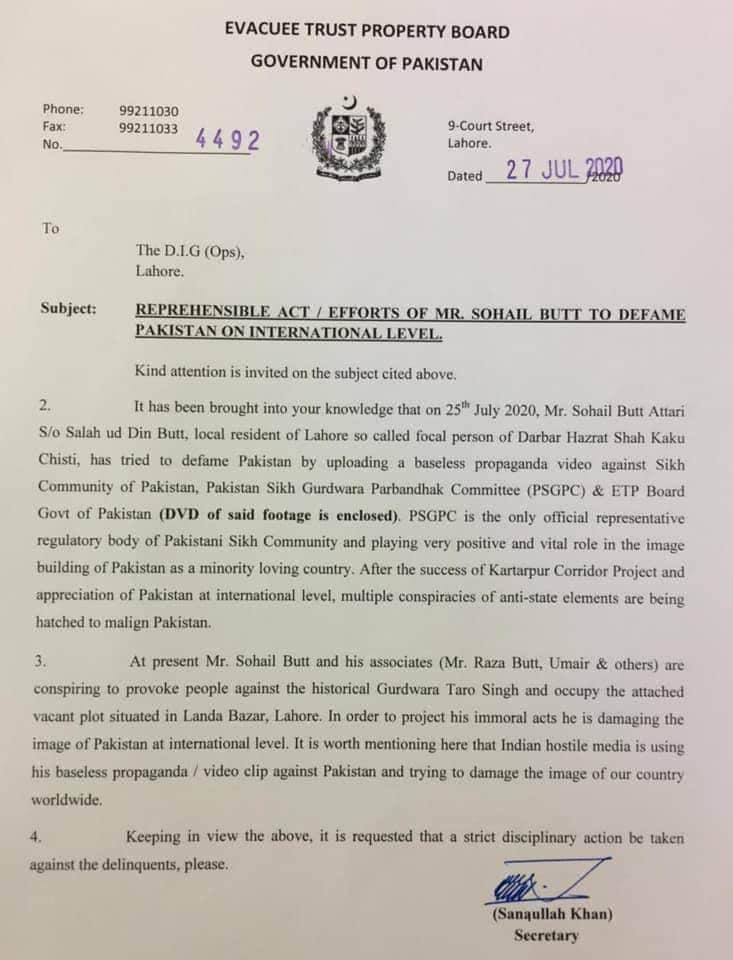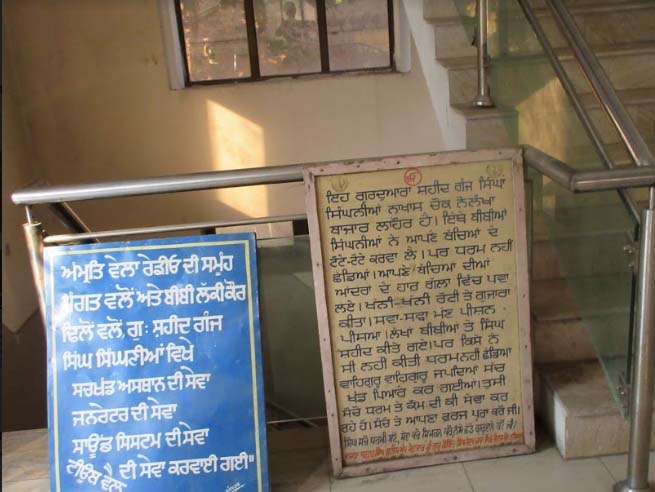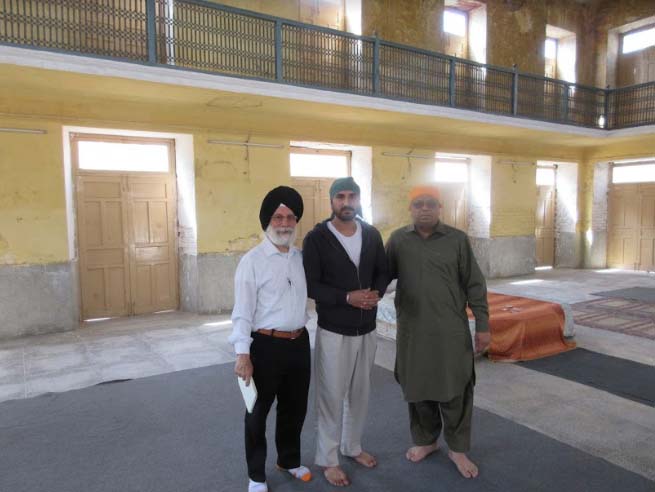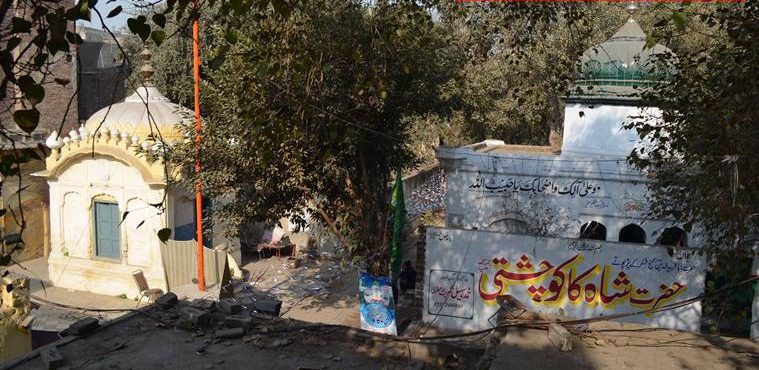The historicity of Gurdwara Shaheed Ganj Lahore and alternative truths
Recently, Indian and Pakistan media and Sikh social media platforms were inundated with news of threat by one Sohail Butt Attari of Lahore to close the historic Gurdwara Shaheed Ganj and open a mosque there. Bhupinder Singh who visited there last year places the situation in perspective. This historic shrine commemorates martyr extraordinaire Bhai Taru Singh, who was then barely 25 years old and got his scalp removed instead of cutting his unshorn hair, setting a classic example of “Sikhi kesan swansa naal nibhe” -let one live the life of a Sikh in every breath with unshorn hair. WSN observes that the historicity of this Gurdwara and the endless court battles for it had many lessons for the Babri Masjid-Ram Janmabhoomi dispute which were bypassed by the Indian political leadership and the Indian judiciary. WSN endorses the call of the author and urges readers to participate in the collective Sikh diplomatic effort to drive home the Sikh viewpoint.
![Recently, Indian and Pakistan media and Sikh social media platforms were inundated with news of threat by one Sohail Butt Attari of Lahore to close the historic Gurdwara Shaheed Ganj and open a mosque there. Bhupinder Singh who visited there last year places the situation in perspective. This historic shrine commemorates martyr extraordinaire Bhai Taru Singh, who was then barely 25 years old and got his scalp removed instead of cutting his unshorn hair, setting a classic example of “Sikhi […]](https://www.theworldsikhnews.com/wp-content/uploads/2020/08/Bhai-taru-Singh-ji-slider-360x266.jpg)
MAULVI SOHAIL BUTT ATTARI, SAID TO BE CARETAKER OF the Darbar Hazrat Shah Kaku Chisti and who runs a shop in Landa Bazar, Lahore, along with some local activists, in a video posted on July 26, 2020, on Facebook, threatened to take over the Gurdwara Shaheed Ganj Bhai Taru Singh and its adjoining 4-5 canals of Gurdwara land, claiming that it actually belongs to Mazar of Muslim prophet Hazrat Shah Kaku Chishti and adjoining Masjid Shaheed Ganj.
The Current Flashpoint:
 Sohail Butt Attari who is an activist of Dawait-e-Islami (Beraillwi) has threatened, “Pakistan is an Islamic nation that belongs to the Muslims.” In the video, he further adds, “During the partition of 1947 when Pakistan was formed, some 20 lakh Muslims sacrificed their lives and now these Sikhs(using derogatory language) are resorting to hooliganism. This is an Islamic nation, how can they do that. All historical records -administrative and historical show that the site belongs to us.”
Sohail Butt Attari who is an activist of Dawait-e-Islami (Beraillwi) has threatened, “Pakistan is an Islamic nation that belongs to the Muslims.” In the video, he further adds, “During the partition of 1947 when Pakistan was formed, some 20 lakh Muslims sacrificed their lives and now these Sikhs(using derogatory language) are resorting to hooliganism. This is an Islamic nation, how can they do that. All historical records -administrative and historical show that the site belongs to us.”
Apparently, this is not happening all of a sudden. In the Pakistan newspaper Dawn, on 12 April 2020, Majid Sheikh reported, “That ruling held the ground till 2012 when a group of Naulakha Bazaar shopkeepers led by a certain Sohail Butt encroached on the land of Gurdwara Bhai Taru Singh and the Shaheed Ganj Gurdwara. They have taken over 90 per cent of the land by curtaining it off. The Sikh leaders of Lahore and Pakistan have tried in vain to reason.”

Now after the recent incident, the Pakistan Evacuee Trust Property Board (ETBP) has lodged a protest to DIG Police on July 27, 2020, regarding the ‘reprehensible act” and named Sohail Butt in the complaint.
The issue is far from resolved. Sohail Butt is attempting to encroach on the famous Sikh history landmark and make it part of a Masjid that does not exist. The possibility of prime property in the old commercial district becoming part of the commercial hub of Landa Bazar could not be ruled out considering that Sohail Butt too has a shop in that market. However, other motives cannot be ruled out either which only time will tell.
History of Gurdwara Shaheed Ganj:
The Shaheed Ganj complex in Naulakha Bazar, Lahore where the Gurdwara stands is associated with Gurdwara Shaheed Ganj Bhai Taru Singh (Shaheedi Asthan -place) and Gurdwara Shahid Ganj Singh Singhnian. Gurdwara Shahidi Asthan is a historic gurdwara where Bhai Taru Singh Ji made the highest sacrifice when his scalp was removed for refusing to cut his hair on 1 July 1745. A separate Gurdwara Singh Singhnian also stands at some distance, commemorating the martyrdom of Sikh men, women and children, who were martyred during Mughal rule in the 18th century.
Mir Mannu, the governor of Lahore, during 1748-53 had raised a building shaped like a mosque sitting where the Muftis -Muslim judges, gave their summary judgments after giving their victims a straight choice between conversion to Islam and death. The martyrdom of Bhai Taru Singh and scores of other Sikhs is ample proof that, in their love of the Sikh way of life, the Sikhs chose the latter.
There have been intermittent attempts to associate Shaheed Ganj mosque (now non-existent) and Darbar Hazrat Shah Kaku Chishti (Dargah -tomb of a saint) to Shaheed Ganj. One is still to see documentation on the subject though there are YouTube videos and tweets making such a claim.
In his magnum opus ‘Lost Heritage -The Sikh Heritage in Pakistan’ author Amardeep Singh makes mention of a case brought by Nur Muhammad in 1850, claiming that a mosque once existed at this place. The court ruled against his claims, but fresh ones were filed in 1854, 1893, 1927, 1935 and 1938 and each time they were dismissed by the relevant courts. The London-based Privy Council, the highest court of appeal during the British era also rejected Muslim claim on May 2, 1940.
“A case was brought by Nur Muhammad in 1850, claiming that a mosque once existed at this place. The London-based Privy Council rejected Muslim claim on May 2, 1940.”
In 1940 in the Bombay High Court, Sikhs won the case which ran as Masjid Shahidganj Mosque versus Shiromani Gurdwara Parbandhak Committee. The exhaustive judgement in the matter is noteworthy.
Significantly, in 2004 Pakistan government had re-built the Gurdwara Shaheed Singh Singhnian which commemorates the martyrdom of Sikh men, women and children brutally killed by Mir Mannu, Abdali’s Governor of Lahore province. To this day, Sikhs recall the martyrdom, saying
ਮਨੂ ਸਾਡੀ ਦਾਤਰੀ। ਅਸੀਂ ਮਨੂ ਦੇ ਸੋਏ…
ਜਿਓਂ ਜਿਓ ਮਨੂ ਵੱਢਦਾ। ਅਸੀਂ ਦੂਨ ਸਵਾਏ ਹੋਏ …
Mannu is the sickle and we are his victims
The more he kills, the more we grow!
Gurdwara Shaheed Ganj in the present times:
Muslims of Lahore did not try converting Gurdwara Shahidi Asthan into a mosque after the mass exodus of Sikhs in 1947. Till recently, though a fewer number of Sikhs visit the shrine, still the place was intact.
In 2010, a mob inflicted damage on the Gurdwara building, the impact of which is still visible. Amardeep Singh in his classic book on the Sikh heritage in Pakistan mentions that during his visit he noticed the presence of fresh rubble along the periphery as an indication of damage in recent years.
During our family visit in March 2019, we too noticed that the shrine has survived for over 72 years after the partition of the sub-continent, despite the fact there are very few Sikhs visit these shrines. Still, the ETPB has done a commendable job of upkeep of these historical places.
“It can be said that the mosque was next to Gurdwara Singh Singhnian and had no relation to the Shaheedi Asthan -the martyrdom place of Bhai Taru Singh.”
We learnt then also that land grabbers are apparently exploiting the situation for pecuniary gains. Yet, the devotion, reverence, and camaraderie that we experienced there are firmly etched in our memories.
Pakistan-based historian and social media activist Shahid Shabbir claims that the mosque structure was next to the Gurdwara Bhai Taru Singh Shaheedi Asthan. It is believed that the mosque, which was allegedly closed after the British took over and Sikh community won a court case, was built during the reign of Mughal emperor Shah Jahan by one of his cooks and completed in the early 1720s.

“Subsequently, a public square and the area around the mosque were allegedly used by the Mughals to persecute and punish the Sikhs and people from other communities who would refuse to convert. They were publicly executed. Taru Singh was also persecuted here,” says he.
“It is believed that the mosque, which was allegedly closed after the British took over and Sikh community won a court case, was built during the reign of Mughal emperor Shah Jahan by one of his cooks and completed in the early 1720s.”
Dalvir Singh Pannu, author of ‘The Sikh Heritage: Beyond Borders’ also believes that the mosque was next to Gurdwara Singh Singhnian and had no relation to the Shaheedi Asthan -the martyrdom place of Bhai Taru Singh.

As quoted in an Indian Express report, Pakistan-based historian Imran William, who is working extensively on the Sikh legacy in Pakistan, contradicts all of them. He says, “There is no documentary proof anywhere that a mosque existed at all. The five-arched structure next to Bhai Taru Singh Shaheedi Asthan was claimed to be a mosque but it was never proved. There is even a question mark on the historical value of the Darbar Hazrat Kaku Chisti. It came up later in a structure which was originally a part of the Gurdwara.”
“There is no documentary proof anywhere that a mosque existed at all.”
A senior Sikh official from Pakistan told The Indian Express, “There is no architectural evidence of any mosque now. The Darbar structure is historical but it wasn’t originally a Darbar. It was part of the Gurdwara and has been converted into a Darbar only in the last few years. There used to be a thara -slab, at the spot of Gurdwara Singh Singhania Singhnian where the Mughals executed Sikh women and children. If at all, the mosque was near it, the Gurdwara building came up later but no one can pinpoint where exactly the mosque was.”
It is historically recorded that the Gurdwara came up in the 1760s after the Bhangi Misl Sikh army conquered Lahore and it is said that the prayers at the mosque were stopped after the Sikhs took over. Later the Gurdwara, it is believed, also received a large jagir (land to maintain its expenses) during Maharaja Ranjit Singh’s reign. It is, however, unclear when exactly the Dargah came up.

The President of the Pakistan Sikh Gurdwara Parbandhak Committee (PSGPC) Satwant Singh has said, “Sikhs around the world are sad to hear news about Gurdwara Shaheed Bhai Taru Singh. The vision of the Pakistani government, especially of Prime Minister Imran Khan is to promote peace and brotherhood. The incident that happened at Shaheedi Asthan was an individual act. There is a plot behind the gurdwara, which is the property of the Evacuee Trust Property Board (ETBP). They plan to take that plot. This is wrong and cannot be tolerated.”
“Sikhs around the world are sad to hear news about Gurdwara Shaheed Bhai Taru Singh. This is wrong and cannot be tolerated.”
“If we take action, it will damage Sikh-Muslim brotherhood. Nor will it be a solution to the problem. I have raised this issue with ETPB and other government departments. We want the government to overcome such problems at its level,” explained Satwant Singh to the worried Sikh world.
ETPB’s secretary Sanaullah Khan has deplored the attempt to usurp the historic Sikh shrine. The complaint filed by ETPB with the police says that after the success of the Kartarpur Corridor project and the widespread appreciation of Pakistan for this unique initiative at the international level, elements inimical to the image of Pakistan are hatching conspiracies to slander the country.
The ETPB has said that Suhail Butt and his colleagues -Raza Butt, Umair, and others conspired to provoke people against Gurdwara Taru Singh and tried to occupy an empty plot next to it in the Landa Bazar, Lahore. He has damaged the image of Pakistan at the international level and strict disciplinary action must be taken.
“After the success of the Kartarpur Corridor project and the widespread appreciation of Pakistan for this unique initiative at the international level, elements inimical to the image of Pakistan are hatching conspiracies to slander the country.
The Indian media and their counterparts on the other side of the Radcliffe line have attempted to muddle the issue linking it to a biased current political narrative. Politically speaking, India’s Ministry of External Affairs has expressed concern at the development while Pakistan Foreign Office has condemned the sinister attempt and reiterated that Pakistan has an empathetic policy towards minorities.
The BBC Punjabi correspondent Ali Qazmi has reported from Lahore that another case was filed in the Lahore High Court. In 1980, the court, for want of evidence ruled in favour of the Sikh community. Since then, the property is with the ETPB.

‘Walking with Nanak’ author Haroon Khalid also affirms that a case was filed in the Lahore High Court for reinstatement of the mosque but the court ruled that, “since no one in living memory could recall offering prayers at this mosque, it was hence a Gurdwara.” It is also learnt that two more cases were filed in the Lahore High Court, but they too were dismissed.
The Shiromani Gurdwara Parbandhak Committee (SGPC) and the Delhi Sikh Gurdwara Management Committee (DSGMC) have deplored the reported activities and called for immediate action to protect the historic place.
Take Action:
Civil society and Sikhs worldwide must take immediate action. In the interest of Sikh-Muslim affinity and peace in the region of South Asia, which can be easily be flared up with such issues, the soft-power of the Sikhs must engage appropriate religious and political forums for a permanent resolution of the issue. It is time for thoroughly conceived diplomatic intervention for drawing the curtains to a three-century-old dispute, which though legally resolved keeps surfacing time and again.
Are you concerned? Will you act? Take any or all of the following steps:
1. Continue to pray in your daily Ardas -supplication to the Guru and the Almighty for the protection and preservation of the historical and religious heritage of the Sikhs in Pakistan.
2. Sikh pilgrims should make individual and collective efforts to regularly visit Gurdwaras and historical sites in Pakistan.
3. Write a polite and accurate email to the ETPB protesting the step taken by Suhail Butt and company, thanking them for their complaint and urging them to follow up this to its logical conclusion. The email address of ETPB is: info@etpb.gov.pk
4. Write a gentle and to-the-point email or tweet to Janab Imran Khan -Prime Minister of Pakistan, urging him to ensure that all efforts to eliminate a famous Sikh historical marker, which is a source of inspiration to Sikhs, are thwarted by the government of Pakistan. His email: info@pmo.gov.pk Twitter:@PakPMO
5. Write an email to the SGPC President saying that a mere media statement is not enough and that the SGPC must appropriately take up the matter with India and Pakistan. Email: info@sgpc.net
6. Write polite letters to newspapers in India and Pakistan quoting historical and religious facts and sharing your anguish and pain.
References:
- https://instant.com.pk/pakistan/203793/
- https://indianexpress.com/article/explained/attempt-to-convert-gurdwara-into-mosque-in-lahore-how-a-pakistan-mans-video-reignited-row-that-began-in-1880s-sparked-mea-protest-6529890/
- https://www.globalvillagespace.com/is-gurdwara-shahidi-asthan-being-used-for-narrative-war/
- https://www.dawn.com/news/1548469
- Singh, Amardeep. Lost Heritage: The Sikh Legacy in Pakistan. The Nagara Trust (2016)
- Pannu, Dalvir S. The Sikh Heritage: Beyond Borders
 Houston-based, spiritually-inclined and much-travelled writer Bhupinder Singh is alert to the religious and historical developments in the Sikh world and is passionate about putting things in the right perspective. He has written many books and articles on Sikh history. Bhupinder Singh is a prolific writer and a regular contributor to The World Sikh News.
Houston-based, spiritually-inclined and much-travelled writer Bhupinder Singh is alert to the religious and historical developments in the Sikh world and is passionate about putting things in the right perspective. He has written many books and articles on Sikh history. Bhupinder Singh is a prolific writer and a regular contributor to The World Sikh News.

4 thoughts on “The historicity of Gurdwara Shaheed Ganj Lahore and alternative truths”